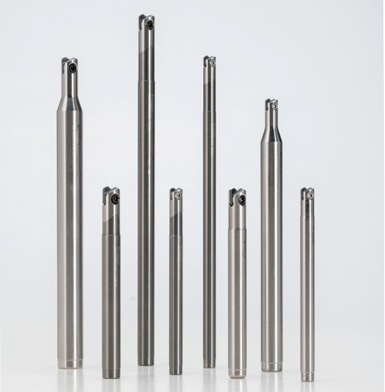High-Feed Performance for Mold and Die Machining Operations
The Ingersoll NanoFeed indexable insert’s applicability for detailed, high-feed rest roughing operations offers mold builders optimized milling performance for miniature components and smaller part features.

Photo Credit: Ingersoll Cutting Tools
Ingersoll’s new NanoFeed technology provides mold builders with exceptional high-feed milling performance for machining of miniature components and smaller part features.
NanoFeed is a 20-degree high-feed indexable insert design that Ingersoll claims will replace smaller diameter solid carbide end mills in a variety of applications. Inserts have been designed with pressed-in coolant channels, directing coolant or air directly to the cutting edge for maximized tool life. Inserts also have backdraft side clearance for straight-wall milling capabilities. Available in 6-mm and 8-mm diameters with steel or carbide shank options, NanoFeed will reportedly reduce cycle times, increase productivity and help to reduce solid carbide usage.
Furthermore, this highly engineered high-feed insert geometry is free cutting, providing excellent stability when in the cut. This is due to a strong and precise offset v-notch clamping system that firmly secures the high-feed insert in the pocket. Increased feed rates along with increased productivity are said to be achieved from the 3X times feed rate multiplier offered with this design. These faster feed rates combined with smaller cutter diameters will enhance many smaller detail roughing operations.
Particularly useful will be the benefits provided when performing detailed, high-feed rest roughing operations, which are a commonly used programing technique in the mold and die industry. Dies and molds of different sizes often have smaller detailed part feature areas that require various types of CAM programming pick-out roughing routines to bring the part in to net-shape prior to finishing. These routines can utilize different types of milling tools as well. Small diameter indexable end mills are a good option when milling these types of details. This is one industry-specific example of where the NanoFeed can offer significant process improvement, whether it’s for high-feed face, contour, shoulder, slot, corkscrew and ramp machining.
Related Content
-
Machining Center Spindles: What You Need to Know
Why and how to research spindle technology before purchasing a machining center.
-
It Starts With the Part: A Plastic Part Checklist Ensures Good Mold Design
All successful mold build projects start with examining the part to be molded to ensure it is moldable and will meet the customers' production objectives.
-
Moldmakers Deserve a Total Production Solution
Stability, spindle speed and software are essential consideration for your moldmaking machine tool.






.png;maxWidth=300;quality=90)





